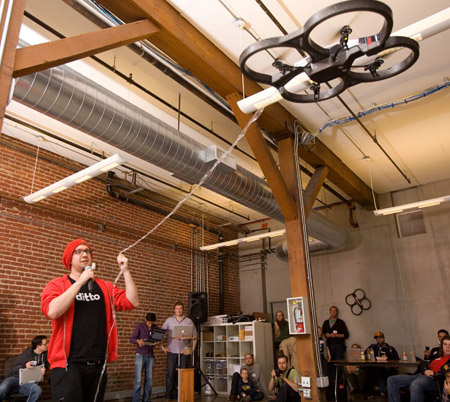AR Drone - a quadrocopter intercepting the communication of other quadrocopters

Four-rotor drones, the so-called quadrocopters, are more than expensive and entertaining toys. Inexpensive, relative to the cost of other aircraft, and universal flying quadrocopters, they are used by military and civilian organizations to conduct reconnaissance, surveillance, photography operations and as flying scientific instruments. Despite all the attractive aspects of quadrocopters, their control systems allow you to perform only a limited number of actions. And in order to attract attention to this problem and demonstrate the expansion of the capabilities of quadrocopter systems, the DroneGames competition was organized, the participants of which present their quadrocopters equipped with unusual and unique capabilities.
The organizer and sponsor of the DroneGames competition is the American Groupon system, which also provides premises for the competition. In addition to Groupon, the organizers are Windows Azure and NodeCopter. This year nine teams took part in the DroneGames competition, and the jury evaluated their creative efforts, which included well-known personalities such as Chris Anderson, founder of DIYDrones and 3DRobotics, Dale Doherty, founder of MAKE, and Andreas Raptopoulos ( Andreas Raptopoulos), one of the founders of Matternet, as well as several other people. The jury estimated not based on the technical complexity of the completed projects, but rather because of the unusual nature of the invention and the results of its application.
The third place was given to the TooTall Nate project, due to which the range of the quadrocopter control distance becomes almost endless due to the Verizon MiFi cellular communication equipment installed on the device. Thanks to this, you can control the drone from any distance, as long as it remains in the area of reliable cellular communication coverage.
The second place was won by a team of newcomers from Stanford, who demonstrated an unusual system that allows controlling a group of quadrocopters of a completely different type from the same computer.
And the first place in the DroneGames competition was given to James Halliday, who wrote a virus that works in the control system of an aircraft and infects all drones that fall into the coverage area of a radio transmitter of an infected device. Infected drones get out of control and "go crazy." But, if we discard the "evil" component of this invention, then we can get a very good system of online software updates for a group of unmanned vehicles that work on a common task.
This competition has every chance of becoming very popular in the next few years. And on the TechCrunch website you can find several videos shot by the contestants, though their quality leaves much to be desired.
